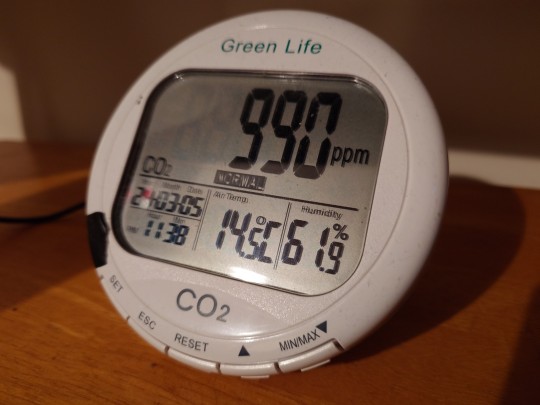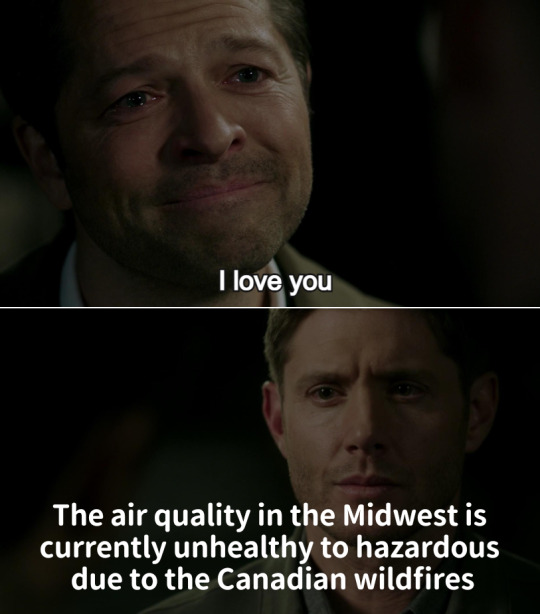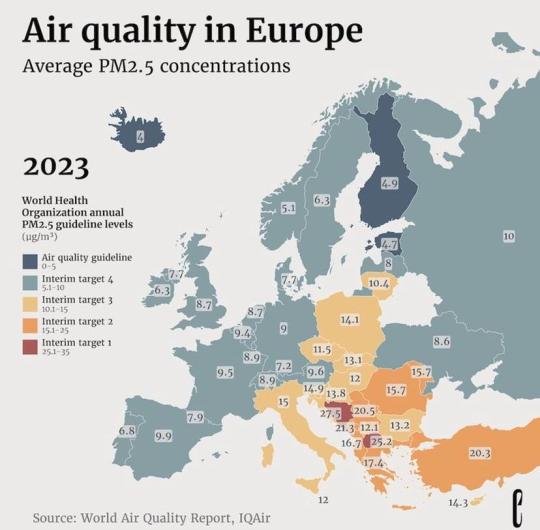#Air quality
Explore tagged Tumblr posts
Text

130K notes
·
View notes
Photo

Air Quality Map of Los Angeles After Fires
by Potato071/reddit
207 notes
·
View notes
Text
Reference preserved in our archive (Daily updates!)
TL;DR: Corsi-Rosenthal Boxes deliver quality air filtration at upwards of 30% higher air exchanges than comparable HEPA filters on the market. Build 'em for covid. Build em' for wildfire smoke. Build 'em for allergies. Build 'em to clean the air.
Abstract Filtration performance of do-it-yourself (DIY) box fan filters deployed across a university campus was assessed over an academic year. Four DIY air filters were constructed from box fans and air filters with a minimum efficiency reporting value (MERV) of 13 and deployed in four spaces (two laboratories that include sources of particles and two offices). They were operated 9 hours daily with a programmable timer and were continuously monitored with power meters. Particle concentrations in the spaces were continuously monitored with low-cost nephelometers. The particle size dependent clean air delivery rate (CADR) and single pass filtration efficiency for each box was measured in a laboratory before deployment and every 10 weeks, for a total of five measurements over 40 weeks. We find that these DIY box fan filters maintain robust performance over time, with each air filter maintaining at least 60% of its initial CADR at the end of the 40 week study even with daily operation in environments with modest particle concentrations. CADR values for particles of 1.0–3.0 μm optical diameter averaged 34% higher than CADR values for 0.35–1.0 μm particles, aligning with MERV 13 filter size-dependent filtration expectations. Reductions in CADR over time were attributed to a reduction in filtration efficiency, likely due to a loss of filter electrostatic charge over time. There was no strong indication that increased resistance due to particle accumulation on filters appreciably decreased flow rates over time for any of the fans. The long-term robustness of DIY box fan air filters demonstrates their validity as a cost-effective, high performance, alternative to portable high efficiency particulate air (HEPA) filters.
#CR box#air filter#clean air#air quality#diy air filtration#covid news#mask up#covid#pandemic#wear a mask#covid 19#public health#still coviding#coronavirus#wear a respirator#sars cov 2#covid conscious#covid is airborne#covid isn't over#covid pandemic#covid19#covidー19#long covid
176 notes
·
View notes
Text

We need climate action.
Digital illustration of a blonde woman wearing a mask facing the New York City skyline. She is standing on a fire-escape wearing a tan dress that reads, ‘climate change is a public health crisis.’
#art#feminism#feminist#illustration#climate change#clean air#wildfire#canada wildfires#air quality#climate action#climate crisis#public health#environmental justice
2K notes
·
View notes
Text

I really like my CO2 meter and I want to tell you about it!
It's a little gadget that measures the amount of carbon dioxide in the air. Did you know your body at rest burns about 100 grams of food/fat an hour? This means you're constantly breathing out carbon dioxide at a rate of about 100 grams an hour. This can rise by quite a lot of you're exercising, and it's less when you're sleeping. This means if you usually keep your doors and windows closed, as I usually do in winter since I live in a cold climate, it can build up fast. You can even breathe directly on the meter and watch the number rise rapidly.
I've had this meter on my desk for many years. It's basically a clock so you can notice the air quality at a glance and it's always on and doesn't produce light. (Note the black tape over the power LED on the left because my autistic ass can NOT sleep with an LED in the room.) It cost about £90 when it was new so it's not the cheapest thing in the world but it's built to last and it's been worth it. This isn't an ad and I'm not saying go for this brand, it's just a gadget that I think improves my life. It's always a good reminder of when I should open the windows.
I'm not 100% sure how well supported this is, but I've seen it said online that a carbon dioxide level of over 1000ppm can lower a person's cognitive function by about 25%. It can be an issue with classrooms with a lot of people. Normal outdoor levels are about 300-400ppm. Whether you believe that is up to you, but I do think fresh air makes people feel better and this serves as a good reminder to let it in. People like to make carbon monoxide jokes on this website, but sometimes high CO2 can be an issue around his you generally feel. It can also build up faster than you'd think if you have multiple people about and no windows open.

Time to open the window! (Apologies for the photo quality, the reflective LCD is not the easiest thing in the world to photograph without shadows or huge reflections.)
462 notes
·
View notes
Text

Bad air this morning. I can almost feel the IQ points shedding from me while I walk. And trust me I have none to spare.
175 notes
·
View notes
Photo


1K notes
·
View notes
Text
"Proving that change is possible if the will to create it is present, Chinese megacities like Beijing that were once famous for their apocalyptic grey skies are enjoying the lowest levels of air pollution they’ve experienced in the 21st century.
Falling 42% from an average high in 2013 when Chinese air pollution was higher than 50 particles per cubic centimeters of city air, the change has increased the lifespan of Chinese urbanites by 2.2 years.
The news comes from a report published by the University of Chicago called the Air Quality Life Index which listed some of the actions taken by the Chinese government to reduce air pollution, described by the CCP as a “war on pollution.”
This has included reducing the presence of heavy industry like steel production in city centers, as well as restricting coal power plants from being built inside cities while shuttering those that were already there.
Some cities like Beijing have reduced the number of cars allowed on the roads during peak hours, similar to London’s congestion charge. Lastly, China’s mass urban tree-planting campaigns have been well documented.
While the life expectancy has risen on average 2.2 years, some cities have seen far more drastic increases. Citizens living under the new “Beijing Blue,” are predicted to live 4 additional years, while those 11 million in the north-central city of Baoding are predicted to gain 6.
“At the foundation of those actions were common elements: political will and resources, both human and financial, that reinforced each other,” the report said. “When the public and policymakers have these tools, action becomes much more likely.”
In fact, the decline in China’s pollution levels has been so drastic that it lowered the world average, which the report says would have increased if not for the Middle Kingdom’s war on pollution.
Although Chinese city air is still several times higher than the WHO’s recommended minimum, it shows what’s accomplishable with political and civic effort—particularly to its neighbors in South Asia where the report warns air quality is worsening."
-via Good News Network, September 1, 2023
#china#pollution#air pollution#coal#carbon emissions#pollution reduction#tree planting#beijing#air quality#aqi#life expectancy#asia#south asia#good news#hope#hope posting
805 notes
·
View notes
Text

source 1 source 2 as of June 27, 2023
update: the smoke has mostly moved east to the new england region and has been in Ontario, Quebec, and areas close to there for months.
#air quality#i thought i would see posts about it like i did for the new york stuff but i guess not#made this because i checked and it's over 200 at my house rn#wildfire smoke#wildfires#maybe we should start recirculating those 'how to stay safe with the smoke' posts in case ppl forgot#poor cas... he's been trying to confess for years but all he's getting from dean is BREAKING NEWS#anyways this isn't breaking news it's been a full day#supernatural#destiel
859 notes
·
View notes
Text

Iceland has the world’s cleanest air, with a PM2.5 average of 3.4 micrograms per cubic meter, thanks to its focus on renewable energy sources like geothermal power.
107 notes
·
View notes
Text
Researchers in the United States and China have discovered a curious link between air pollution and suicide rates that prompts us to reconsider how to approach this issue. China's efforts to reduce air pollution have prevented 46,000 suicide deaths in the country over just five years, the researchers estimate. The team used weather conditions to tease apart confounding factors affecting pollution and suicide rates, arriving at what they consider to be a truly causal connection. The results, published in Nature Sustainability, unearth air quality as a key factor influencing mental health.
Continue Reading.
229 notes
·
View notes
Text

This is why I have an Aranet CO2 monitor. I use it everywhere. The higher the CO2 the more likely you can become infected with a virus.
https://aranet.com/en/home/products/aranet4-home?srsltid=AfmBOoqCZYt7R7BUSVxXQrDkhtA4zGOvTT__gFvFdbDkSOdtsqcJGuxo
65 notes
·
View notes
Photo

Air quality in Europe, 2023.
99 notes
·
View notes
Text
Also preserved in our archive
Not covid, but another great reason to keep masks on hand: Fine particulate matter increases all sorts of other health issues like asthma, high blood pressure, some cancers, and even strokes. Pollution is just as bad for you as covid in some senses.
By Alden Woods and Kiyomi Taguchi
As Baby Boomers hit retirement, about 1 in 6 Americans is now over the age of 65. The number of Americans living with dementia is projected to skyrocket — but the proportion of older Americans who develop dementia has actually decreased. The exact reason why is uncertain, but various lifestyle and environmental factors can influence a person’s risk of cognitive decline.
One recently discovered risk is air pollution. Studies have linked exposure to a type of air pollution called fine particulate matter, or PM2.5, with an increased risk of developing dementia, and researchers suspect that some sources of PM2.5 may pose a greater risk than others.
New research led by the University of Washington found that wildfire smoke is especially hazardous. An analysis of the health care records of 1.2 million Southern California residents found that higher long-term smoke exposure was associated with a significant increase in the odds that a person would be diagnosed with dementia.
The researchers presented their findings at the Alzheimer’s Association International Conference in July and published the full study Nov. 25 in JAMA Neurology.
“There have been studies that have found total PM2.5 is related to people developing dementia, but no one had looked specifically at wildfire PM2.5,” said lead author Joan Casey, a UW associate professor of environmental & occupational health sciences. “Wildfire smoke is a different animal, in that it’s much spikier. There are many days where there’s no wildfire smoke, and there are some days where exposure is really, really extreme.”
Researchers analyzed the health records of 1.2 million members aged 60 and older of Kaiser Permanente Southern California between 2008 and 2019, all of whom were free from dementia at the start of the study period. They estimated each person’s long-term exposure to both wildfire and non-wildfire PM2.5 as a three-year rolling average, and then identified people who received a dementia diagnosis.
Researchers found that for every 1 microgram per cubic meter (µg/m3) increase in three-year average wildfire PM2.5 concentration, the odds of a dementia diagnosis increased by 18%. Exposure to non-wildfire PM2.5 also increased a person’s risk of dementia, but to a much lesser degree.
“One microgram per meter cubed might sound fairly small, but we have to think about how people are exposed to wildfire smoke,” Casey said. “Most days they aren’t exposed at all, so this might represent a few days of exposure at a concentration of something like 300 µg/m3, where the AQI is over 200 in someone’s community. When you think about it, it’s actually a few really severe wildfire smoke days that might translate into increased risk.”
That risk further increased among racialized people and those living in high-poverty census tracts, following long-term trends in which vulnerable populations often experience disproportionate effects of environmental hazards. The authors suggested that disparities might be related to lower-quality housing, which can increase the amount of smoke that enters people’s homes, or lower-income families’ inability to afford air filtration systems.
The study period does not include the summers of 2020 and 2021, which produced the most extreme wildfire seasons recorded in California. The climate crisis has drastically increased the frequency and severity of wildfires across the American West, introducing “smoke season” in many West Coast regions The influx of smoke has chipped away at air quality improvements made over the last century.
“The main culprit here is climate change,” Casey said. “It’s a global problem. While individuals can protect themselves with air filters and masks, we need a global solution to climate change. It’s going to have to be many-pronged — many people have to be involved to solve this highly complex problem.”
Co-authors on this study are Holly Elser of the University of Pennsylvania; Timothy Frankland of the Kaiser Permanente Hawaii Center for Integrated Health Research; Chen Chen and Tarik Benmarhnia of the Scripps Institution of Oceanography at UC San Diego; Sara Tartof and Gina Lee of Kaiser Permanente Southern California; Elizabeth Rose Mayeda of UCLA; Dr. Alexander Northrop of Columbia University; and Jacqueline Torres of UC San Francisco. This research was funded by the National Institute on Aging and the National Institute for Environmental Health Sciences.
Study link: jamanetwork.com/journals/jamaneurology/article-abstract/2827124
#clean air#air quality#respiratory health#mask up#public health#wear a mask#wear a respirator#masking#masks#masks work
39 notes
·
View notes
Text

cursed daughter of a blessed mother who is the blessed daughter of a cursed mother who is the cursed daughter of a cursed mother
#star's shinies#khr#uni khr#yuni khr#personally I subscribe to the parthenogenesis theory of sky arcobaleno creation#it would explain their lack of partner (earthling genes should be diluted over generations if they were mating with humans#and there is no confirmed fathers)#the short and somewhat deranged (looking at you Luce) timeframes#their short lifespans could also be a byproduct of this! a common issue in genetically identical populations is that#a) offspring will always inherit any genetic disease or predispositions the parent had#and b) that unless there is a random mutation populations cannot adapt to changes- in this case it could be human diet#air quality#disease#pretty much anything considering how little we know about Earthlings#essentially whatever caused Sepira's death her descendants would also be very vulnerable to#this could also explain why the pacifier doesn't pass outside their family!#if they are all an unbroken line of clones it may all read them as the same owner#in a normal situation its not very likely for a stronger sky to never be born in the whole world#especially considering the arms races the Underworld is always in regarding stronger flames weapons and powers (estraneo)#all this to explain why I drew her belly button as the black lily symbol (I thought it was a cute idea) which you can barely see anyway lol
40 notes
·
View notes
Text



Many of us in Western Washington and the Pacific Northwest remember the days when we didn’t have a “smoke season.” Mount Rainier National Park is being periodically impacted by smoke from regional wildfires like the Retreat Fire, burning to the east of the park. The current hot, dry forecast creates ideal conditions for fires to start and spread. Please do your part to help wildfire crews working on the current fires and reduce future fire risk:
1) Always check fire conditions and restrictions and the air quality index before heading out on your adventure. Air quality for several park locations is available at: https://go.nps.gov/MountRainierAirQuality
2) Give ‘em a brake – slow down in areas where fire crews are present.
3) Control your campfires. While fires are still currently allowed in park campgrounds, visitors should practice vigilant fire safety. Always keep water nearby and completely drown your campfires when done. Never leave a burning campfire. If it’s warm to the touch, it’s too warm to leave. Propane or butane powered stoves are a great alternative to campfires.
4) Don’t drive or park on vegetation! Parking on dry vegetation not only damages the vegetation, but engine heat and leaking fluids can lead to increased fire risk.
5) Towing a boat or camper? Secure your chains! Unsecured chains can spark and cause wildfires.
6) If you fly, we can’t - Drones are prohibited in national parks and near wildfires and can interfere with wildland fire aircraft. Leave your drone at home.
7) If you smoke, ash your cigarettes in ashtrays & always make sure butts are fully extinguished before properly discarding in trash receptacles.
NPS/D. Divelbiss Photos of wildfire smoke obscuring views of Mount Rainier from various locations in the park.
75 notes
·
View notes